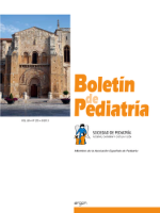Fístula en H: a propósito de un caso
M. Palacios Sánchez , I. Alegría Echauri , E. Alegría Echauri , E. Pérez Belmonte , M.J. Cabero Pérez
Bol. Pediatr. 2013; 53 (225): 168 - 171
La fístula traqueoesofágica es la malformación congénita más frecuente del tracto respiratorio, con una incidencia 1/3.500 recién nacidos. Existen 5 tipos según su anatomía, siendo la fístula en H la menos frecuente. Esta variedad no se asocia a atresia de esófago, por lo que su diagnóstico es más tardío. Presentamos un niño de 6 años con antecedentes de prematuridad tardía. Desde el mes y medio de vida presenta episodios de regurgitaciones, tos y broncoespasmo. La gammagrafía evidencia episodios de reflujo gastroesofágico, sin paso a vía aérea; se instaura tratamiento con omeprazol, domperidona y monitorización domiciliaria, con mejoría de la clínica digestiva, persistiendo episodios de broncoespasmo. Con sospecha de asma del lactante inicia tratamiento con corticoides inhalados a dosis crecientes con control parcial de los síntomas. Fue diagnosticado de neumonía a los 4 años, con posterior exacerbación de su sintomatología, atragantamiento con líquidos y dificultad respiratoria. La pHmetría constata reflujo gastroesofágico patológico. El tránsito con bario evidencia paso de contraste a tráquea y bronquios principales a través de trayecto fístuloso de 7 mm de longitud y 3 mm de grosor entre cara anterior del esófago y posterior de la tráquea, sugestivo de fístula en H. Intervenido quirúrgicamente, disminuyen los episodios de broncoespasmo, sin síntomatología intercrisis. El 4% de las fístulas traqueoesofágicas son en H. Su diagnóstico suele ser tardío, en relación con problemas respiratorios crónicos, reflujo gastroesofágico y episodios de atragantamiento con líquidos. Generalmente presentan buen pronóstico, dependiendo de la asociación con atresia esofágica u otras anomalías (VACTERL).
H-type fistula: A case report
Tracheoesophageal fistulea are the most frequent congenital abnormality of the respiratory tract, with an incidence of 1/3,500 in newborns. There are 5 types according to it anatomy, the H-type fistula being the least frequent. This variety is not associated to esophageal atresia, so that its diagnosis is later.
We present the case of a 6-year old boy with background of late preterm. He presented episodes of regurgitations, coughing and bronchospasms beginning at one month and a half of life. The scintigraphy showed episodes of gastroesophageal reflux, that did not pass to the airway. Treatment was initiated with omeprazole, domperidone and home monitoring. There was improvement of the digestive symptoms, the bronchospasm episodes persisting. Due to suspicion of asthma of the infant, treatment was begun with inhaled corticosteroids in growing doses with partial control of the symptoms. He was diagnosed of Pneumonia at 4 years of age, with subsequent exacerbation of his symptoms, chocking with liquids and respiratory distress. The Ph meter showed pathological gastroesophageal reflux. The barium transit showed passage of the contrast to the trachea and main bronchi through the fistulous pathway of 7 mm in length and 3 mm thick between the anterior face of the esophageal and posterior one of the tracheal, suggestive of H fistula. He was operated on, decreasing the episodes of bronchospasm, without inter-episode symptoms.
A total of 4% of the tracheal-esophageal fistulae are in H. These are usually diagnosed late, in relation with chronic respiratory problems, gastroesophageal reflux and episodes of choking with liquids. There prognosis is generally good, depending on the association with esophageal atresia or other abnormalities (VACTERL).
Artículo completo (PDF) (91 kb.)
- Cirugía
